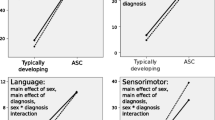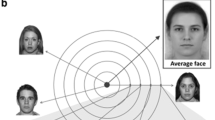Abstract
Comparisons were made between male and female children with autism, 384 boys and 91 girls, aged 3 years to 8 years, on nonverbal measures of intelligence, adaptive functioning, receptive vocabulary, perception, and eye-hand integration, and on ratings of affect, play, and relating and human interest. Males showed more advanced performances on eye-hand integration and perception skills on the Psychoeducational Profile (PEP) and had higher nonverbal IQs social quotients, and Peabody Picture Vocabulary Test (PPVT) IQs than females. When nonverbal IQ was controlled, the main effect of sex remained; however, sex differences on PPVT scores and on eye-hand integration and perception scale disappeared. Males showed more unusual visual responses and less appropriate, more stereotypic play than females. These results are discussed in terms of hypotheses concerning sex differences in genetic thresholds and in hemispheric lateralization.
Similar content being viewed by others
References
Arthur, G.The Arthur adaptation of the Leiter International Performance Scale. Chicago: Psychological Service Center Press, 1952.
Bayley, N.Manual for the Bayley Scales of Infant Development. New York: Psychological Corporation, 1969.
Bradshaw, J. L., Gates, A., & Nettleton, N. C. Bihemispheric involvement in lexical decisions: Handedness and a possible sex difference.Neuropsychologia, 1977,15, 277–286.
Bryden, M. P. Sex-related differences in cerebral organization. In M. A. Wittig & A. C. Peterson (Eds.),Sex-related differences in cognitive functioning. New York: Academic Press, 1979. Pp. 121–144.
Coleman, M. A report on the autistic syndromes. In M. Rutter & E. Schopler (Eds.),Autism: A reappraisal of concepts and treatment. New York: Plenum Press, 1978.
Damasio, A., & Maurer, R. A neurological model for childhood autism.Archives of Neurology, 1978,35, 777–786.
Doll, E. A.Vineland Social Maturity Scale. Circle Pines, Minnesota: American Guidance Service, 1965.
Dunn, L. M.Expanded manual for the Peabody Picture Vocabulary Test. Minneapolis: American Guidance Service, 1965.
Hollingshead, A., & Redlich, F.Social class and mental illness. New York: Wiley, 1958.
Lotter, V. Factors related to outcome in autistic children.Journal of Autism and Childhood Schizophrenia, 1974,4, 263–277.
Maccoby, E., & Jacklin, C. N.The psychology of sex differences. London: Oxford University Press, 1975.
Prior, M. P., & Bradshaw, J. L. Hemispheric functioning in autistic children.Cortex, 1979,15, 73–82.
Schopler, E., & Reichler, R.Psychoeducational Profile: Individualized assessment and treatment for autistic and developmentally delayed children. Baltimore: University Park Press, 1979.
Schopler, E., Reichler, R., DeVellis, R., & Daly, K. Toward objective classification of childhood autism: Childhood Autism Rating Scale (CARS).Journal of Autism and Developmental Disorders, 1980,10, 91–103.
Springer, S. P., & Deutsch, G.Left brain, right brain. San Francisco: W. H. Freeman, 1981.
Stutsman, R. Guide for administering the Merrill-Palmer Scale of Mental Tests. In L. M. Terman (Ed.),Mental measurement of preschool children. New York: Harcourt, Brace & World, 1931. Pp. 139–262.
Symmes, J. Evaluating competence and accessibility in autistic children. In M. Coleman (Ed.),The autistic syndromes. New York: Elsevier, 1976.
Tsai, L., Stewart, M. A., & August, G. Implication of sex differences in the familial transmission of infantile autism.Journal of Autism and Developmental Disorders, 1981,11, 165–173.
Wechsler, D.Wechsler Intelligence Scale for Children — Revised. New York: Psychological Corporation, 1974.
Wing, L. K.Early childhood autism. Oxford: Pergamon, 1976.
Wing, L. Sex ratios in early childhood autism and related conditions.Psychiatry Research, 1981,5, 129–137.
Wing, L., Gould, J., Yeates, S. R., & Brierley, L. M. Symbolic play in severely mentally retarded and in autistic children.Journal of Child Psychology and Psychiatry, 1977,18, 167–178.
Author information
Authors and Affiliations
Additional information
Our thanks are extended to the parents and children who participated in the initial TEACCH diagnostics, and to Robert DeVellis and Barbara Renner for help with computer programming and statistical advice.
Rights and permissions
About this article
Cite this article
Lord, C., Schopler, E. & Revicki, D. Sex differences in autism. J Autism Dev Disord 12, 317–330 (1982). https://doi.org/10.1007/BF01538320
Issue Date:
DOI: https://doi.org/10.1007/BF01538320




